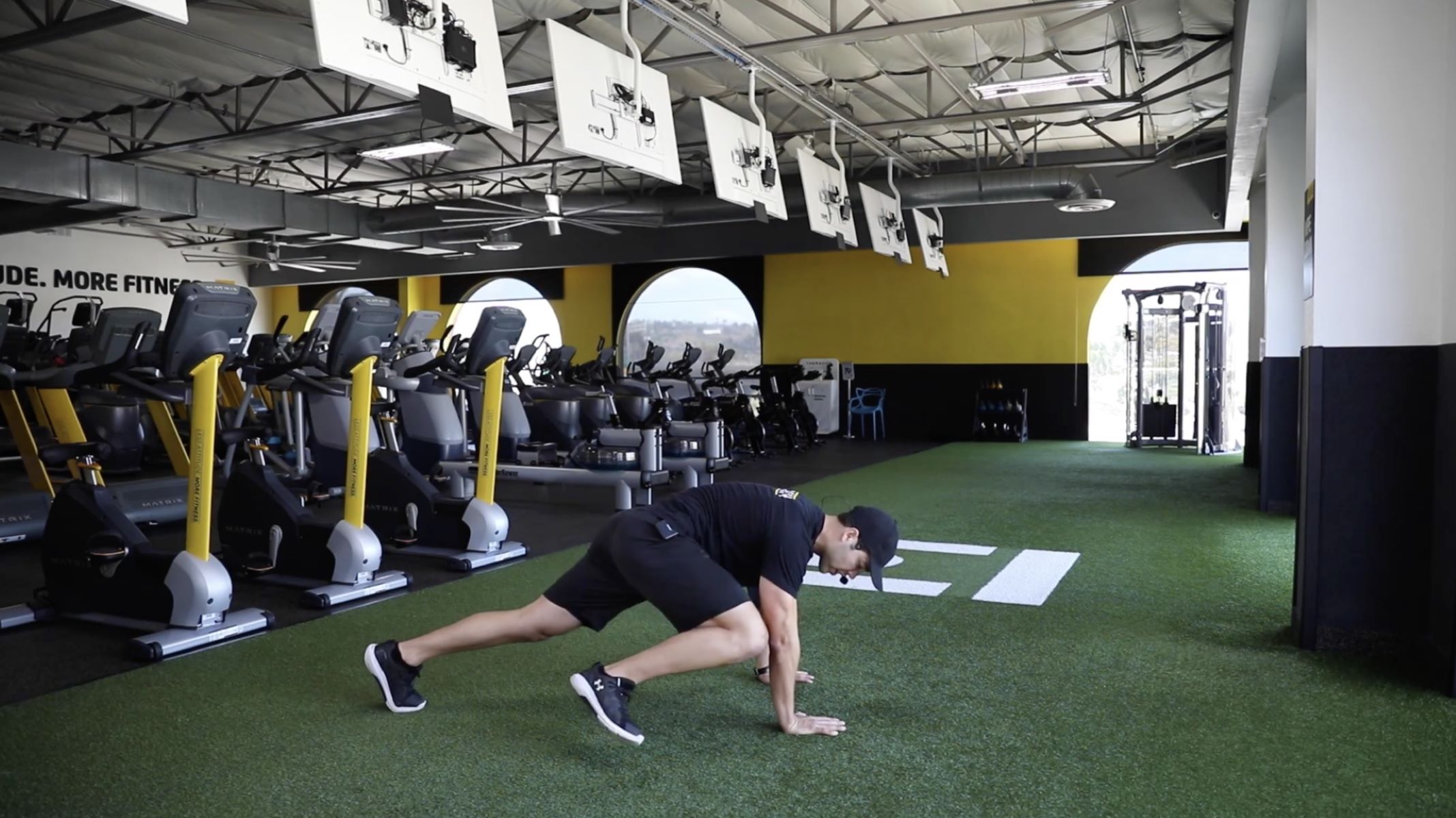Home>Misc>Featured>Which Weight Training Concept Should Be Followed In Order To Develop Muscular Endurance?


Featured
Which Weight Training Concept Should Be Followed In Order To Develop Muscular Endurance?
Modified: March 2, 2024
Discover the featured weight training concept for developing muscular endurance and achieve your fitness goals.
Introduction
Muscular endurance is a crucial aspect of physical fitness that plays a significant role in various activities and sports. It refers to the ability of a muscle or group of muscles to sustain repeated contractions over an extended period. Developing muscular endurance not only enhances one’s physical performance but also contributes to overall strength, stamina, and resilience.
Whether you’re an athlete training for a specific sport or someone looking to improve their fitness level, understanding the different weight training concepts for developing muscular endurance is essential. These concepts involve specific techniques, exercises, and training protocols that target the muscles’ endurance capacity.
In this article, we will explore various weight training concepts that can be followed to develop muscular endurance effectively. Each concept has its unique approach and benefits, allowing individuals to tailor their workouts according to their needs and preferences.
Before delving into the specific training concepts, it’s important to recognize the significance of muscular endurance in fitness. Muscular endurance plays a vital role in everyday activities such as walking, climbing stairs, and carrying groceries. It also contributes to sports performance, allowing athletes to maintain their power and performance over an extended period of time.
Improving muscular endurance can have wide-ranging benefits, including increased stamina, reduced fatigue, enhanced muscle tone, and improved overall fitness levels. Whether you’re an endurance athlete, a recreational sportsperson, or someone looking to improve their daily functional movements, focusing on developing muscular endurance can greatly contribute to your physical well-being.
Factors such as genetics, training intensity, nutrition, and recovery play a role in determining an individual’s muscular endurance capacity. However, by incorporating effective weight training concepts into your fitness routine, you can maximize your potential and achieve your muscular endurance goals.
Definition of Muscular Endurance
Muscular endurance refers to the ability of a muscle or group of muscles to sustain repeated contractions over an extended period without fatigue. It is a crucial component of physical fitness, particularly in activities that require prolonged muscle exertion, such as running, cycling, swimming, and weightlifting.
Muscular endurance is different from muscular strength, which is the maximum force a muscle can generate in a single contraction. While both strength and endurance are important, developing muscular endurance focuses on increasing the muscle’s ability to perform repetitive contractions over time, rather than lifting or pushing heavy loads.
There are various factors that contribute to muscular endurance. One important factor is the muscle fibers involved. Muscles are made up of two main types of fibers: slow-twitch (Type I) and fast-twitch (Type II). Slow-twitch fibers are more resistant to fatigue and are primarily responsible for endurance activities. Fast-twitch fibers, on the other hand, are more powerful and contribute to activities that require short bursts of intense effort.
In addition to muscle fiber composition, other factors that influence muscular endurance include cardiovascular fitness, oxygen utilization, energy production, and the efficiency of the neuromuscular system. These factors can be improved and optimized through specific training techniques and protocols.
It’s important to note that muscular endurance is specific to the muscle or muscle group being trained. For example, someone with good endurance in their leg muscles may not necessarily have the same level of endurance in their upper body muscles.
Measuring muscular endurance can be done through various tests and assessments. Common methods include timed exercises such as push-ups, sit-ups, plank holds, or a certain distance covered in a specific time frame. These tests provide a quantitative measure of an individual’s muscular endurance performance and can be used to track progress over time.
Training for muscular endurance involves incorporating exercises and training techniques that challenge the muscle’s ability to sustain contractions for prolonged periods. By gradually increasing the intensity, duration, and frequency of these exercises, individuals can progressively improve their muscular endurance capacity.
Now that we have a clear understanding of what muscular endurance is, let’s explore the weight training concepts that can be used to develop this essential aspect of physical fitness.
Importance of Muscular Endurance in Fitness
Muscular endurance plays a vital role in overall physical fitness and has numerous benefits for individuals of all fitness levels. Let’s explore why developing muscular endurance is important:
1. Enhanced Stamina and Endurance: Muscular endurance training improves your body’s ability to perform activities for longer periods without experiencing fatigue. This is especially beneficial for endurance athletes, such as runners, cyclists, and swimmers, who need to sustain their performance over extended periods of time.
2. Improved Functional Strength: Muscular endurance training also enhances functional strength, which is the ability to perform everyday activities with ease and efficiency. Improved muscular endurance allows you to carry out tasks like lifting, carrying, and pushing objects for longer durations without feeling tired or strained.
3. Reduced Fatigue: By increasing the muscles’ capacity to endure prolonged contractions, muscular endurance training helps reduce the onset of fatigue during physical activities. This means you can participate in sports or workouts for longer durations without feeling exhausted.
4. Increased Metabolic Rate: Muscular endurance training can elevate your metabolic rate, leading to increased calorie burning during and after exercise. This can contribute to weight management and overall body composition improvement.
5. Enhanced Muscle Tone and Definition: By consistently challenging the muscles with endurance-based exercises, you can promote muscle growth and develop lean muscle mass. This results in improved muscle tone, definition, and an aesthetically pleasing physique.
6. Injury Prevention: Strong muscles with good endurance provide better support to joints, ligaments, and tendons, reducing the risk of injuries. Muscular endurance training helps in reinforcing the stabilizing muscles around the joints, which can help prevent common injuries, especially in activities involving repetitive motions.
7. Improved Cardiovascular Health: Muscular endurance training often involves exercises that elevate heart rate and engage the cardiovascular system. Regular participation in such exercises can improve heart and lung function, leading to better cardiovascular health and increased overall fitness.
8. Greater Resilience and Performance: Developing muscular endurance enhances your body’s ability to withstand fatigue and maintain optimal performance levels during demanding physical activities. This can be particularly beneficial for competitive athletes who need to sustain their performance throughout their events or competitions.
These are just a few of the many reasons why muscular endurance is important in fitness. Incorporating specific weight training concepts and techniques aimed at developing muscular endurance will help you reap these benefits and improve your overall fitness level.
Factors Affecting Muscular Endurance Development
Several factors influence an individual’s ability to develop muscular endurance. Understanding these factors can help you tailor your training program to optimize your results. Let’s explore the key factors affecting muscular endurance development:
1. Muscle Fiber Composition: The type and proportion of muscle fibers in your body play a significant role in determining your muscular endurance capacity. Slow-twitch (Type I) muscle fibers have higher endurance capabilities, while fast-twitch (Type II) muscle fibers are more powerful but fatigue faster. Genetic factors largely determine your muscle fiber composition.
2. Training Intensity: The intensity at which you perform your workouts directly impacts your muscular endurance development. To enhance endurance, you need to challenge your muscles with exercises that stimulate the slow-twitch muscle fibers. This typically involves performing high repetitions with lighter weights and focusing on maintaining proper form and technique.
3. Aerobic Capacity: Muscular endurance and aerobic capacity go hand in hand. Your body’s ability to deliver oxygen to the working muscles and efficiently utilize it plays a vital role in sustained muscle contractions. To improve muscular endurance, incorporating cardiovascular exercises such as running, cycling, or swimming can help boost your aerobic fitness level.
4. Recovery and Rest: Adequate recovery and rest between training sessions are crucial for muscular endurance development. Overtraining or not allowing enough time for the muscles to recover can result in diminished performance and increased risk of injury. Make sure to include rest days in your training program and prioritize sleep and proper nutrition to support muscle recovery.
5. Nutrition: Providing your body with the necessary nutrients, especially carbohydrates and protein, is essential for muscular endurance development. Carbohydrates serve as the primary fuel source for endurance activities, while protein helps in repairing and building the muscles. Ensure you have a well-balanced diet that supports your training goals.
6. Training Variety: Incorporating a variety of exercises and training techniques can help prevent plateaus and stimulate continuous improvement in muscular endurance. Mixing up your workouts with different exercises, training methods, and resistance levels challenges the muscles in different ways, promoting overall endurance development.
7. Mental Focus and Mindset: Endurance activities can be mentally taxing, and having the right mindset plays a crucial role in pushing through fatigue and maintaining effort levels. Developing mental resilience and focus through techniques such as visualization, positive self-talk, and goal setting can significantly impact your ability to sustain muscular endurance.
It’s important to note that these factors interact with each other and should be considered holistically when designing your training program. Analyze your strengths and weaknesses in each area and customize your approach accordingly. Consulting with a fitness professional can help you create a personalized plan that maximizes your muscular endurance development.
Weight Training Concepts for Developing Muscular Endurance
When it comes to developing muscular endurance, there are several weight training concepts and techniques that you can incorporate into your workouts. These concepts focus on challenging the muscles to sustain repeated contractions over an extended period of time. Here are some effective weight training concepts for developing muscular endurance:
- High Repetition Training: This concept involves performing exercises with a high number of repetitions. It targets the slow-twitch muscle fibers, improving their endurance capacity. For example, instead of performing 8-10 reps with heavy weights, you would aim for 15-20 reps with lighter weights.
- Circuit Training: Circuit training involves performing a series of exercises in sequence with minimal rest in between. This concept keeps the muscles engaged and the heart rate elevated, improving both muscular endurance and cardiovascular fitness.
- Supersets and Dropsets: Supersets involve performing two exercises back-to-back without resting in between, targeting the same muscle group. Dropsets, on the other hand, involve starting with a higher weight and progressively reducing the weight as you reach fatigue. Both concepts enhance muscular endurance by pushing the muscles to their limits.
- Tempo Training: Tempo training focuses on controlling the speed of each repetition. Slowing down the eccentric (lengthening) portion of the movement and emphasizing the contraction can increase time under tension and challenge the muscles’ endurance capacity.
- Isometric Training: Isometric exercises involve holding a contraction without any movement. This concept helps in developing static strength and muscular endurance, as the muscles are engaged for an extended period of time without the need for repetitive movements.
- Peripheral Heart Action Training: This concept involves alternating between upper and lower body exercises in a circuit format. By alternating between different muscle groups, it helps maintain a higher heart rate, promoting both muscular endurance and cardiovascular fitness.
- Pyramid Training: Pyramid training involves gradually increasing the weight lifted while decreasing the number of repetitions in each set. This concept challenges the muscles at different intensities, targeting both strength and endurance.
- Continuous Tension Training: This concept involves performing exercises with a continuous slow and controlled movement, without pausing or locking out the joints. The aim is to keep constant tension on the muscles, stimulating endurance adaptations.
- Time Under Tension Training: This concept focuses on increasing the time of each repetition by slowing down the movement or incorporating pauses at various points. By prolonging the time the muscles are under tension, it enhances endurance capacity.
It’s important to note that these weight training concepts can be combined and modified to suit individual needs and goals. The key is to progressively overload the muscles and continually challenge their endurance capacity. Consulting with a fitness professional can help you design a workout plan that incorporates these concepts effectively and fits your specific requirements.
High Repetition Training
High repetition training is a weight training concept specifically designed to develop muscular endurance. This training method involves performing exercises with a high number of repetitions, typically ranging from 15 to 20 or even more. The objective is to challenge the slow-twitch muscle fibers, which are responsible for endurance activities.
When performing high repetition training, lighter weights are used compared to strength or power-focused workouts. The focus is on maintaining proper form and technique throughout the entire set, rather than lifting the heaviest weights possible. This allows the muscles to endure a sustained effort over an extended period.
The key benefits of high repetition training include:
1. Increased Endurance Capacity: By repeatedly contracting the muscles over a prolonged period, high repetition training stimulates the slow-twitch muscle fibers, boosting their endurance capacity. This can enhance overall muscular endurance, allowing individuals to sustain physical activities for longer durations without experiencing fatigue.
2. Improved Muscle Tone: High repetition training promotes muscle growth and can lead to improved muscle tone and definition. The sustained contractions during each repetition increase blood flow and nutrient delivery to the muscles, promoting muscle development and sculpting a more aesthetically pleasing physique.
3. Time Efficiency: High repetition training can be a time-efficient method of building muscular endurance. With shorter rest periods between sets and higher repetitions, individuals can complete their workouts more quickly, making it ideal for those with a busy schedule.
4. Cardiovascular Benefits: High repetition training elevates heart rate and stimulates cardiovascular adaptation. This can improve cardiovascular fitness, enhancing the heart’s ability to pump blood and deliver oxygen to the working muscles more efficiently.
5. Fat Burning: High repetition training can contribute to fat loss and weight management. The increased metabolic demand during exercise and the sustained elevation of heart rate can lead to higher calorie expenditure during and even after the workout.
When incorporating high repetition training into your workout routine, it’s important to start with an appropriate weight that challenges you but allows you to complete each set with proper form. As you progress, you can gradually increase the resistance to continue challenging your muscles and further improve endurance.
Remember to listen to your body, avoid overtraining, and allow for adequate recovery between high repetition training sessions. Combining high repetition training with other weight training concepts and cardiovascular exercises can help you achieve a well-rounded and effective fitness program.
Circuit Training
Circuit training is a highly effective weight training concept that combines resistance exercises in a sequential circuit format. It involves moving from one exercise to the next with minimal rest in between. Circuit training is specifically designed to improve muscular endurance, cardiovascular fitness, and overall strength.
The key components of circuit training include performing a series of exercises that target different muscle groups or movement patterns. These exercises are typically performed using bodyweight, free weights, or machines, depending on the individual’s preferences and resources. The circuit can consist of 6-10 different exercises, and each exercise is performed for a set duration or number of repetitions before moving on to the next.
The benefits of circuit training for muscular endurance development are manifold:
1. Improved Muscular Endurance: As you move through the circuit, each exercise challenges different muscle groups, allowing for overall muscular endurance development. The continuous pace of the circuit ensures that the muscles are consistently engaged, leading to enhanced endurance capacity.
2. Increased Cardiovascular Fitness: Circuit training elevates the heart rate, providing a cardiovascular workout in addition to the muscular endurance component. The combination of resistance training and aerobic exercise in a circuit format can improve cardiovascular fitness, enhancing the heart’s ability to pump blood and oxygen to the working muscles.
3. Time Efficiency: Circuit training is known for its time efficiency. Since it combines multiple exercises in a continuous flow, it allows for a full-body workout in a shorter amount of time compared to traditional strength training or cardio sessions. This makes it an ideal choice for individuals with busy schedules who are looking to maximize their workout time.
4. Versatility and Adaptability: Circuit training can be customized to individual needs and goals. The exercises included in the circuit can be modified based on fitness level, equipment availability, and desired intensity. This versatility ensures that people of different fitness levels and backgrounds can participate and benefit from circuit training.
5. Fat Burning and Weight Management: Circuit training can have a significant impact on calorie burning and fat loss. The combination of resistance exercises and consistent movement keeps the heart rate elevated, resulting in increased calorie expenditure both during and after the workout. This can support weight management and body composition improvement.
When designing a circuit training routine, it’s important to consider the exercises included, the duration or number of repetitions for each exercise, and the intensity of the overall circuit. The circuit can be structured to target specific muscle groups or emphasize certain movement patterns based on individual goals and preferences.
Proper form, technique, and rest intervals should also be incorporated to ensure safety and maximize the benefits of circuit training. Consulting with a qualified fitness professional can help you create a well-structured and effective circuit training program tailored to your specific needs and goals.
Supersets and Dropsets
Supersets and dropsets are innovative weight training concepts that can significantly contribute to the development of muscular endurance. These techniques involve modifying the traditional approach of performing straight sets of exercises in order to challenge the muscles in a different way and promote endurance adaptations.
Supersets:
In superset training, exercises are performed back-to-back without resting in between. Supersets typically involve targeting the same muscle group or opposing muscle groups. There are two main types of supersets:
- Compound Supersets: In compound supersets, two exercises are performed back-to-back, targeting different muscle groups. For example, performing a set of squats immediately followed by a set of push-ups. This allows for efficient use of time and incorporates both upper and lower body movements.
- Isolation Supersets: Isolation supersets involve performing two consecutive sets of exercises that target the same muscle group. For example, performing a set of bicep curls immediately followed by a set of tricep kickbacks. This technique is particularly effective for achieving a deep burn and endurance-focused muscle stimulation.
Supersets challenge the muscles by increasing the time under tension, keeping the muscles engaged throughout the consecutive sets. This results in increased muscle endurance as the targeted muscle group must work through fatigue in order to complete the superset. By incorporating supersets into your training routine, you can improve muscular endurance and optimize your workouts in a time-efficient manner.
Dropsets:
Dropsets involve gradually reducing the weight used during a set to extend the duration of the exercise. This technique is commonly used to push the muscles to their limits and induce muscle fatigue. The idea behind dropsets is to continue the exercise with a lower weight immediately after reaching muscular failure with a higher weight. This allows for additional reps to be performed, further challenging the muscles and promoting endurance adaptations.
Dropsets can be applied to various exercises, such as dumbbell curls or leg presses. They are effective in developing muscular endurance as they require the muscles to endure a sustained effort, performing repetitions with decreasing resistance. By incorporating dropsets into your training program, you can push past plateaus and stimulate continuous improvements in muscular endurance.
Both supersets and dropsets offer unique challenges to the muscles, promoting endurance development and pushing you to new limits. It is important to note that these techniques should be approached with caution and proper form should always be maintained to prevent injury. Consulting with a fitness professional can help you incorporate supersets and dropsets effectively into your training routine and tailor them to your specific goals and needs.
Tempo Training
Tempo training is a weight training concept that focuses on controlling the speed or tempo of each repetition in order to target specific muscle fibers, stimulate muscle growth, and enhance muscular endurance. By manipulating the timing of the concentric (muscle shortening) and eccentric (muscle lengthening) phases of a repetition, tempo training challenges the muscles in a different way, promoting endurance adaptations.
In tempo training, the tempo is typically expressed as a series of four numbers, such as 3-1-2-0. Each number represents the time (in seconds) spent on a specific phase of the movement during a repetition. Let’s break down what each number signifies:
- Eccentric Phase: The first number represents the time spent on the eccentric phase, which is the lengthening or lowering of the muscle. For example, in a squat, it would indicate the time it takes to descend down towards the ground.
- Pause at Bottom or Midpoint: The second number represents the time taken to pause or hold the position at the bottom or midpoint of the movement. It allows for increased time under tension and a greater challenge for the muscles.
- Concentric Phase: The third number represents the time spent on the concentric phase, which is the shortening or lifting portion of the movement. It indicates the time it takes to push or pull the weight back to the starting position.
- Pause at Top or Midpoint: The last number represents the time taken to pause or hold the position at the top or midpoint of the movement. Similar to the pause at the bottom or midpoint, it increases time under tension and further challenges the muscles.
By controlling the tempo and focusing on the eccentric and concentric phases of each repetition, tempo training helps in engaging more muscle fibers and prolonging the time under tension. This leads to greater muscular endurance and strength adaptations.
For example, using a slower eccentric phase can increase the time the muscles are under tension, creating metabolic stress and promoting endurance development. Conversely, using a slower concentric phase can enhance muscle control and power output during explosive movements.
Tempo training can be applied to a wide range of exercises, including squats, bench presses, bicep curls, and more. It is important to tailor the tempo to each exercise and individual goals. You can experiment with different tempos and find what works best for you.
Integrating tempo training into your workout routine can help break through plateaus, increase muscular endurance, and improve overall muscle control and strength. However, it is important to note that tempo training should be approached gradually, with proper form and technique maintained throughout the movement. Consulting with a fitness professional can help you incorporate tempo training effectively into your workouts and design a program that aligns with your specific needs and goals.
Isometric Training
Isometric training is a weight training concept that focuses on holding a static contraction without any movement. Unlike traditional weightlifting exercises that involve concentric and eccentric muscle contractions, isometric exercises involve maintaining a position or holding a specific pose for a set period of time. This form of training is highly effective for improving muscular endurance and strength.
When performing isometric exercises, the muscle fibers engage and generate tension, but there is no change in muscle length. This static contraction stimulates the muscles in a unique way, challenging their endurance capacity by holding the contraction for an extended duration. Isometric training can be performed using bodyweight, free weights, or resistance bands.
The benefits of isometric training for muscular endurance development include:
1. Increased Muscular Stamina: Isometric training provides a sustained challenge to the muscles, promoting endurance adaptations. By holding a static contraction for an extended period, the slow-twitch muscle fibers are activated and compelled to endure the sustained effort.
2. Improved Joint Stability: Isometric exercises require the muscles surrounding the joints to engage and stabilize, leading to improved joint stability and reduced risk of injuries. This can be particularly beneficial for individuals involved in sports or activities that place repetitive stress on the joints.
3. Practical Application: Many real-life activities and sports require isometric muscular endurance, such as holding a position in yoga, maintaining a plank position, or holding a defensive stance in basketball. Incorporating isometric training into your routine can enhance your performance in these activities.
4. Time Efficiency: Isometric training can be a time-efficient way to build muscular endurance. These contractions can be held for shorter durations, making it a convenient option for individuals with limited time for workouts.
5. Increased Mind-Muscle Connection: Isometric training allows individuals to develop a better mind-muscle connection, reinforcing the ability to recruit and activate specific muscle groups effectively. This enhanced connection can improve muscle control, coordination, and overall muscular endurance.
Common isometric exercises include planks, wall sits, static lunges, and the infamous “Wall Push” exercise. These exercises can be modified based on fitness level, duration, and intensity. It’s important to start with proper form and gradually increase the duration of the contractions as you build strength and endurance.
Isometric training can be incorporated into your workout routine as standalone exercises or combined with other weight training concepts. Adding isometric holds to supersets or circuit training can further challenge the muscles and provide a comprehensive workout targeting both endurance and strength.
As with any training concept, it’s important to listen to your body, maintain proper form, and consult with a fitness professional to ensure that isometric training is suitable for your individual needs and goals.
Peripheral Heart Action Training
Peripheral Heart Action (PHA) training is a weight training concept that combines upper body and lower body exercises in a circuit format. This unique training method targets both muscular endurance and cardiovascular fitness by alternating between different muscle groups in a systematic and progressive manner.
PHA training works on the principle of blood flow redistribution. By alternating between upper and lower body exercises, the heart is constantly pumping blood to different parts of the body, resulting in an increased cardiovascular demand. This promotes enhanced muscular endurance and cardiovascular fitness simultaneously.
The main components of PHA training include:
1. Compound Exercises: PHA training primarily focuses on compound exercises that engage multiple muscle groups at once. Examples of compound exercises include squats, deadlifts, lunges, bench presses, rows, and overhead presses.
2. Circuit Format: PHA training is performed in a circuit format, where exercises are performed consecutively without resting in between. The goal is to keep the heart rate elevated and maintain continuous movement throughout the circuit.
3. Alternating Muscle Groups: The circuit alternates between upper body and lower body exercises to distribute blood flow efficiently and challenge different muscle groups. This continuous shifting of blood flow enhances the cardiovascular demand and stimulates muscular endurance.
Some benefits of PHA training for muscular endurance development include:
1. Improved Muscular Endurance: PHA training challenges the muscles of both the upper and lower body, leading to improved endurance capacity. The constant switching between muscle groups stimulates the slow-twitch muscle fibers, promoting muscular endurance development.
2. Increased Cardiovascular Fitness: PHA training elevates heart rate throughout the workout due to the continuous movement and alternating muscle groups. This cardiovascular demand enhances the heart’s capacity to deliver oxygen-rich blood to working muscles, improving overall cardiovascular fitness.
3. Efficient Calorie Burn: PHA training combines strength and cardio exercises, resulting in a higher calorie burn during and after the workout. The increased heart rate, coupled with the continuous movement, produces an intense metabolic effect, making it an effective strategy for weight management.
During a PHA workout, exercises are performed with moderate weights, allowing for higher repetitions and sustained effort. The goal is to maintain proper form and technique while keeping the intensity of the workout high.
It is important to note that PHA training can be tailored to an individual’s fitness level and goals. The exercises, weights, and duration of each circuit can be modified to suit personal preferences and abilities. Consulting with a fitness professional can help you design a PHA training program that is specific to your needs and helps you achieve your desired level of muscular endurance and cardiovascular fitness.
Pyramid Training
Pyramid training is a weight training concept that involves progressively increasing or decreasing the weight and/or repetitions of an exercise within a set. This method is commonly used to enhance both muscular strength and endurance by challenging the muscles at different intensities throughout the workout.
In pyramid training, the weight or repetitions are adjusted in a structured manner, creating a pyramid-like progression. There are two main types of pyramid training:
- Ascending Pyramid: In an ascending pyramid, the weight is gradually increased while the repetitions decrease. This means that each set, the weight is increased while the number of repetitions is reduced. For example, starting with a lighter weight for a higher number of repetitions and progressively adding weight and decreasing repetitions with each subsequent set.
- Descending Pyramid: In a descending pyramid, the weight is gradually decreased while the repetitions increase. This means that each set, the weight is reduced while the number of repetitions is increased. For example, starting with a heavier weight for a lower number of repetitions and progressively decreasing weight and increasing repetitions with each subsequent set.
The benefits of pyramid training for developing muscular endurance include:
1. Muscular Adaptation: Pyramid training challenges the muscles by progressively increasing or decreasing the weight and repetitions, stimulating endurance adaptations. By exposing the muscles to different intensities, the slow-twitch muscle fibers are utilized and pushed to sustain contractions for prolonged periods.
2. Progressive Overload: Pyramid training allows for a progressive overload approach, which is essential for muscle development and adaptation. This method continually challenges the muscles by increasing the weight or repetitions, promoting increased endurance capacity and strength.
3. Time Efficiency: Pyramid training can be a time-efficient way to train multiple aspects of muscular fitness. By combining both strength-focused and endurance-focused sets within a single workout, you can optimize your training time and work towards your muscular endurance goals.
Pyramid training can be applied to various exercises, such as squats, bench presses, or dumbbell curls. The specific weight increments and repetition ranges can be modified based on individual fitness levels and goals.
It’s important to note that pyramid training requires careful attention to choosing appropriate weights to ensure proper form and technique. Starting with a weight that allows for comfortable execution and progressively increasing or decreasing the intensity will help you avoid injury and maximize the benefits of pyramid training.
As with any training concept, it’s important to listen to your body, maintain adequate rest and recovery, and consult with a fitness professional to tailor pyramid training to your specific needs and goals. By incorporating pyramid training into your routine, you can effectively improve your muscular endurance and overall fitness level.
Continuous Tension Training
Continuous tension training is a weight training concept that focuses on maintaining constant tension on the muscles throughout the entire exercise. This technique aims to maximize time under tension, stimulating muscular endurance and promoting muscle growth.
In continuous tension training, the movement is performed in a slow and controlled manner, avoiding any pauses or resting positions. By eliminating moments of relaxation within the exercise, the muscles remain engaged and activated, resulting in continuous activation of muscle fibers and increased endurance capacity.
The key benefits of continuous tension training for developing muscular endurance include:
1. Increased Time Under Tension: Continuous tension training extends the time that the muscle fibers are under tension compared to traditional weightlifting exercises. This stimulates both the slow-twitch and fast-twitch muscle fibers, promoting endurance adaptations.
2. Enhanced Muscle Control: The focus on maintaining tension throughout the entire movement requires greater muscle control and coordination. This can improve your ability to recruit and activate targeted muscles, leading to better overall muscular endurance and performance.
3. Improved Muscle Definition: Continuous tension training promotes muscle growth and can contribute to improved muscle definition. The constant engagement of the muscles during each repetition increases blood flow and nutrient delivery, supporting muscle development and toning.
4. Increased Metabolic Stress: The sustained tension on the muscles in continuous tension training results in increased metabolic stress. This metabolic stress stimulates the production of growth factors, promoting muscle endurance adaptations and potentially contributing to fat burning.
Exercises commonly performed with continuous tension training include movements like slow and controlled squats, lunges, bicep curls, and chest presses. It’s important to select a weight that allows you to maintain a slow and controlled tempo throughout the exercise. Avoid using momentum or relying on other muscle groups to compensate for the lack of tension.
Proper form and technique are crucial in continuous tension training to effectively target the muscles and minimize the risk of injury. Focus on maintaining a stable and controlled movement, and avoid jerking or using excessive momentum.
Continuous tension training can be incorporated into your regular weight training routine or used as a focused training method for specific muscle groups. By implementing this technique, you can optimize your workouts for muscular endurance development and experience the benefits of enhanced muscle control, definition, and overall strength.
Time Under Tension Training
Time under tension (TUT) training is a weight training concept that prioritizes the duration of each repetition rather than the number of repetitions or the amount of weight lifted. This training method focuses on prolonging the time that the muscles are under tension during each set, which is a key factor in developing muscular endurance.
During time under tension training, the tempo and pacing of each repetition are adjusted to keep the muscles engaged for an extended period. This prolonged duration of tension stimulates both slow-twitch and fast-twitch muscle fibers, promoting endurance adaptations and improving muscular endurance capacity.
The benefits of time under tension training for muscular endurance development include:
1. Increased Time for Muscular Adaptation: Time under tension training provides an extended stimulus for muscle adaptation. By keeping the muscles under tension for a longer duration, this method promotes endurance adaptations, such as increased capillary density and improved oxidative capacity.
2. Enhanced Metabolic Stress: Prolonged time under tension increases metabolic stress, which can lead to the activation of anabolic pathways and the production of growth factors. This can contribute to muscle growth, improved endurance, and potentially fat burning.
3. Muscle Fiber Recruitment: Time under tension training recruits a larger number of muscle fibers throughout the set, as the sustained tension necessitates the activation of both slow-twitch and fast-twitch muscle fibers. This comprehensive activation promotes muscular endurance development across a broad range of muscle fiber types.
4. Improved Muscle Control and Mind-Muscle Connection: Time under tension training requires focus and concentration, enhancing muscle control and the mind-muscle connection. This improved connection allows for better coordination and engagement of the targeted muscle groups, leading to greater muscular endurance and control.
Implementing time under tension training involves using a controlled tempo throughout each repetition. This can be achieved by incorporating a slower eccentric (lengthening) phase, emphasizing the contraction, or adding pauses at different points during the movement. The specific tempo and duration of each set can be tailored to individual goals and fitness levels.
Exercises commonly used in time under tension training include squats, bench presses, shoulder presses, and bicep curls. It’s important to choose an appropriate weight that allows you to maintain proper form and execute each repetition with the desired tempo and duration.
Remember to gradually progress in duration and intensity as you adapt to time under tension training. Consistency and gradual overload are key to continual improvement in muscular endurance and overall fitness.
By incorporating time under tension training into your weightlifting routine, you can effectively target and develop muscular endurance, leading to improved stamina, strength, and overall physical performance.
Conclusion
Developing muscular endurance is a crucial aspect of physical fitness that allows us to sustain activities over an extended period without experiencing fatigue. By incorporating various weight training concepts into our fitness routines, we can effectively target and improve our muscular endurance capacity.
In this article, we explored several weight training concepts for developing muscular endurance. These concepts include high repetition training, circuit training, supersets and dropsets, tempo training, isometric training, peripheral heart action training, pyramid training, continuous tension training, and time under tension training.
Each of these concepts offers unique benefits and methodologies to challenge the muscles and promote endurance adaptations. Incorporating a variety of these training techniques into your workouts not only keeps your training regimen interesting and engaging but also optimizes your results by stimulating diverse muscle fibers and promoting well-rounded muscular endurance development.
It’s important to note that while focusing on developing muscular endurance, we should also consider other aspects of fitness, such as cardiovascular conditioning, flexibility, and overall strength. By maintaining a balanced approach to fitness, we can support our muscular endurance goals while enhancing our overall physical well-being.
In conclusion, understanding and implementing the weight training concepts discussed in this article can provide a solid foundation for developing muscular endurance. It is recommended to consult with a fitness professional to tailor these concepts to your specific needs, goals, and abilities. Consistency, progressive overload, and proper form should be emphasized to optimize training benefits and minimize the risk of injury. With dedication and a well-rounded approach to fitness, you can improve your muscular endurance and enhance your overall fitness level.









